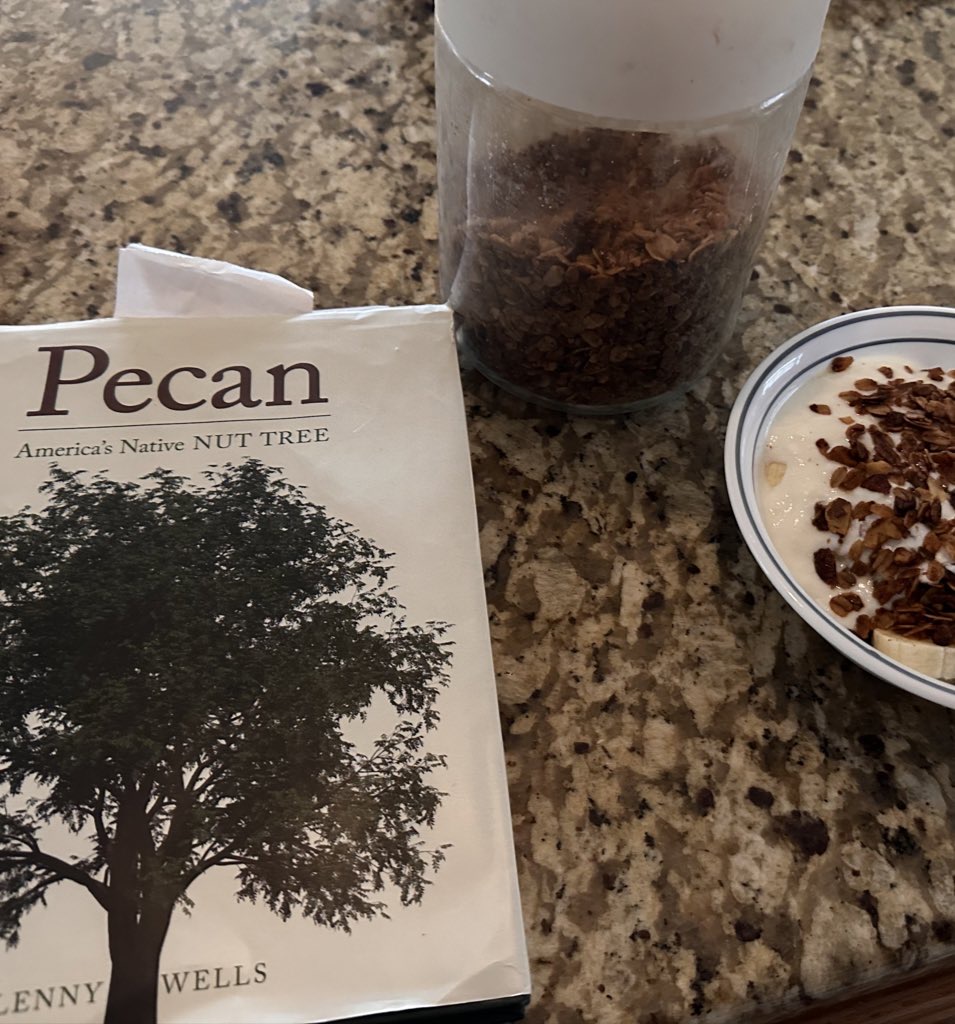Lenny Wells, Pecan: America’s Native Nut Tree

(Tuscaloosa, AL: University of Alabama Press, 2017), 264 pages plus color plates of illustrations.
Growing up in North Carolina, I remember pecan trees on my great grandparents’ farms. Pecans were often linked to Christmas. I would find nuts in my stocking along and we’d eat pecan pies, sweet potato casserole with a pecan topping, and blueberry salad with a pecans and cream cheese topping. I assumed pecans were native to the area and used, along with everything else on the homestead, to provide a mostly self-sufficient estate. In reading this book, I learned otherwise.
Pecan expanding range
While Pecans are native to the Americas, their native range was somewhere along the Mississippi River, up to Missouri and Illinois, and along riverbanks in Texas and the north half of Mexico. Yet, no one is really sure where they originally developed. Pecan nuts may have been transported by humans and planted (or accidentally dropped and planted) even before the European conquest of the New World. This could have broadened their range.
The widespread planting of pecans in Georgia and the Carolinas began in the 19th Century. By the end of the 20th Century, one can find the tree growing across the southern half of the United States (from the Atlantic to New Mexico), along with places in South America, Australia, the Middle East, and China.
History of Pecans
Wells documents pecan history. The nut was a food stable among Native American tribes and helped keep lost Spanish conquistadors alive. They have even found their way into space as a snack for astronauts. Thanks to the marketing skills of Karo corn syrup, pecan pies are now a holiday staple in many parts of the country. However, pecan pies are like creamed spinach, taking something healthy and making it unhealthy. But with the extra sugar (and bourbon and butter and other things that go well with pecans), they are one of the healthiest nuts available.
Diversity within the trees.
Pecans are grown in the wild, in backyards, and in large commercial orchards. And planting a nut one is not sure of what kind of pecan will grow as nuts from the same tree may produce different results. The only way to insure you are reproducing a particular tree is grafting. Pecans are also one of the most diverse trees with lots of subspecies. This diversity protects the nut from disease. Wells outlines the growth of the pecan industry, the challenges of raising the nut, and how such orchards and nuts can be good for the environment and our bodies.
Humorous anecdotes
This book is well written and contains numerous wonderful stories about those who have been involved in the pecan business. He also provides many humorous anecdotes, such as the businessman who gave out a prize for the largest pecans, as a way to find valuable trees to reproduce. Visiting the winning tree on a riverbank in Texas, he found most of the limbs cut off. Locals cut the limbs as ways to harvest the nuts. That story seems like a metaphor for much of human development. And it rings true of those big-headed Texans. While Wells discusses technical aspects of growing such trees, such as grafting and soil types, he conveys scientific information in a manner that a lay person can understand.
There’s more I’d like to know
Upon finishing the book, I wanted to know more. Wells never mentions pecan as a wood product, yet it’s a rich and beautiful wood that can be used as veneer for plywood and for gunstocks. Maybe my wondering about alternative uses for the tree makes me a bit of heretic, for Wells has dedicated his life to the nut.
I am also curious about the relationship between the pecan and the American Chestnut. A blight wiped out the chestnut in the early 20th Century. Both trees provided nuts for pioneers in addition to providing a cash crop for those welling to gather and sell such nuts. Wells does discuss the relationship between pecans and hickory and walnuts. To modify a pecan for swampy soil, graft a pecan scion to a water hickory stock. Finally, I would have liked to have seen a list of the major types of pecans and their characteristics. Wells mentions dozens of varieties and it was hard to keep them straight. One variety, the Cape Fear, I was especially curious about as my great grandparents’ farms were in the Cape Fear River basin.
An additional recipe from me
At the back of this book, Wells includes some recipes. I’ll add my recipe to the mix as I eat a 1/3 cup of this every morning in a bowl of fruit and homemade yogurt.
Homemade Granola
3 cups finely chopped pecans
6 cups old fashion oats
¾ cup of olive oil
¾ cup of maple syrup
2 tablespoons of vanilla
1+ tablespoon of cinnamon
1+ tablespoon of sea salt
Mix in a large bowl until everything blended. Line two baking sheets with parchment paper. Split the mix and spread over the parchment. Bake at 325 degrees for 20 minutes. Stir the mixture and return to the oven for another 20 minutes. Store for 3 months in a glass sealed container. If storing longer, place the granola into storage bags and freeze.

I love all kinds of nuts. I can eat a handful of mixed nuts when I am feeling low on energy because they are good for a low carb snack in moderation. I used to love granola but can’t eat it anymore.
I eat all kind of nuts, too. Making your own granola can reduce the sugars and you could increase the nuts and reduce the oats, to reduce carbs.
What an interesting post on the pecan, Jeff! I’m going to make your granola. It’s so hard to find a healthy cereal in the stores, and both Terry and I love granola. Thanks for sharing your recipe.
I hope you enjoy the granola, Louise. I am going to try it with the addition of coconut (per Bob’s suggestion)
I was late to the game on pecans and sort of mad at myself for not trying it sooner. Thanks for the recipe. Sounds like it would go great in my yogurt.
It should never too late to try something new, Matt!
I’m a nut for any kind of nut, and pecans are at the top of my list of favorites. My mother-in-law (someone I loved dearly) couldn’t eat enough pecan pie, so I set out to perfect one just for her and baked it each Christmas. Thanks for the granola recipe. I’m going to put that together and give it a try. Merry Christmas and Happy New Year!
I’d love to try your pie, Lee. I have enjoyed pecan pies (my mom made a good one), but have never tried to make on myself. Maybe I should.
Addendum: Your recipe does in fact contain salt (somehow missed that and I also use sea salt), so the only difference in ours is the coconut. I’m a fan, but I know others are not.
Kelly and I grew up together, so I’m with her on the pronunciation! It’s my favorite nut.
Who knew a book on pecans could be so enlightening? I have a similar granola recipe, but it includes coconut and a little salt, both of which can be omitted if those tastes are not desired. It is really good, though.
I will try adding coconut to my granola. That sounds like a good addition, thanks!
We love pecans at our house (I say puh-KAHN). I was thrilled when a friend gave us a huge sack of cracked and blown nuts not long ago. Most went in the freezer, but I’ve also made two pies and a few batches of cookies. And, of course, snacked on some.
That looks like a tasty granola recipe!
While not quite a cookie, my favorite shortbread recipe uses pecans and bourbon (which pairs well with the butter and brown sugar). All this talk about people making pies makes me want to try!
I’ve attempted many a pecan pie recipe, but the most successful for me has always been the one shown on the label of a Light Karo Syrup bottle.
it’s interesting that Karo Syrup had a role in making pecan pie popular.
I guess because I’ve heard your southern drawl before, I couldn’t help but pronounce pecan pe-can in my brain every time I read the word in this post. It overruled my native pa-con pronunciation. Interesting about scientists not knowing the origins of the tree. I wish we could grow them here. I like them more than our native black walnuts.
Like the native location, which can’t be pinpointed, he didn’t really settle the pronunciation of nut! I love black walnuts, but they are such a mess to deal with and require way too much work!
I’d forgotten how great pecan pie is–and homemade granola. Love your recipe.
I wonder how many pecan pies this post has inspired? 🙂
And the granola. It is best homemade.
Yes, it is and you only put in it what you want, no hidden sugars or additives. I’m going to try adding coconut to mine since I enjoy it.